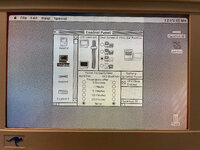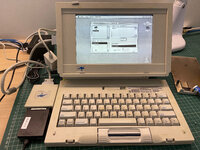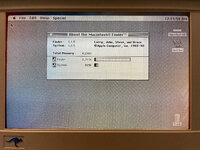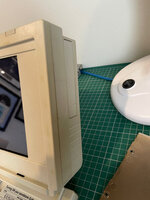cheesestraws
Well-known member
The story so far:
The Outbound Laptop was an early Mac-compatible laptop, roughly contemporaneous with the Macintosh Portable, but smaller and lighter. Apple couldn't stop them making computers but would not permit them to distribute Mac ROMs. So they functioned with a ROM transplant; you provided ROMs from an SE or a Plus and this brought your Laptop to life. Unfortunately, this left you with the husk of the SE or Plus, ROM-less. Which was an expensive thing to waste.
So instead of just being a laptop, Outbound also made the Laptop dockable, by plugging it into your old SE or Plus. Or, to look at it another way, the laptop could also act as an accelerator-in-a-box, providing a faster CPU, a second screen, and more storage options to your SE. And then you could pick up your accelerator and take it with you as a laptop. Like a cross between a PowerBook Duo and a Radius Rocket.
You could also plug other peripherals into your laptop through this docking port; there were floppy drive and SCSI options. I believe that was it.
The docking kit is, these days, basically unobtainable except if one is wildly lucky. The computers with the docking boards in got separated from the laptops, looked just like non-working machines, were thrown away. If it walks like rubbish and quacks like rubbish, it is likely to get thrown away. Such is life—one cannot keep everything.
I have merely been unreasonably lucky and have the docking card for the SE winging its way to me, but no cable harness for it. So since I know there are other people around who are interested in this machine and who have other peripherals, I thought we could have a chat about stuff in here and about the docking port and protocol, whatever it turns out to be.
[cinematic wibbly effect]
@trag tells me that the SCSI and floppy adapters both have a 85C30 as the first thing after the docking connector thing. @trag, (or @ScutBoy, I can't remember if you have these), if you have a moment would you mind poking one of these with a multimeter and seeing what pins on the 85C30 connect to what pins on the connector? (Also 5 V and ground if time permits). Not looking for a full pinout, don't worry - and not urgent of course, but I think a good first step here would be working out vaguely how the laptop knows whether to talk serial or whateverthehellitis over the docking port, because the docking card does not include an 85C30.
The Outbound Laptop was an early Mac-compatible laptop, roughly contemporaneous with the Macintosh Portable, but smaller and lighter. Apple couldn't stop them making computers but would not permit them to distribute Mac ROMs. So they functioned with a ROM transplant; you provided ROMs from an SE or a Plus and this brought your Laptop to life. Unfortunately, this left you with the husk of the SE or Plus, ROM-less. Which was an expensive thing to waste.
So instead of just being a laptop, Outbound also made the Laptop dockable, by plugging it into your old SE or Plus. Or, to look at it another way, the laptop could also act as an accelerator-in-a-box, providing a faster CPU, a second screen, and more storage options to your SE. And then you could pick up your accelerator and take it with you as a laptop. Like a cross between a PowerBook Duo and a Radius Rocket.
You could also plug other peripherals into your laptop through this docking port; there were floppy drive and SCSI options. I believe that was it.
The docking kit is, these days, basically unobtainable except if one is wildly lucky. The computers with the docking boards in got separated from the laptops, looked just like non-working machines, were thrown away. If it walks like rubbish and quacks like rubbish, it is likely to get thrown away. Such is life—one cannot keep everything.
I have merely been unreasonably lucky and have the docking card for the SE winging its way to me, but no cable harness for it. So since I know there are other people around who are interested in this machine and who have other peripherals, I thought we could have a chat about stuff in here and about the docking port and protocol, whatever it turns out to be.
[cinematic wibbly effect]
@trag tells me that the SCSI and floppy adapters both have a 85C30 as the first thing after the docking connector thing. @trag, (or @ScutBoy, I can't remember if you have these), if you have a moment would you mind poking one of these with a multimeter and seeing what pins on the 85C30 connect to what pins on the connector? (Also 5 V and ground if time permits). Not looking for a full pinout, don't worry - and not urgent of course, but I think a good first step here would be working out vaguely how the laptop knows whether to talk serial or whateverthehellitis over the docking port, because the docking card does not include an 85C30.

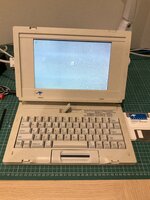
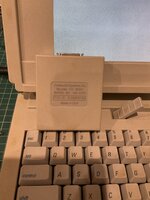
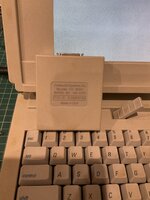
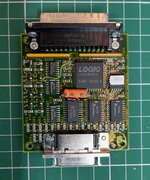
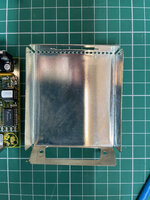
![IMG_1514[1].JPG IMG_1514[1].JPG](https://forumbucket.us-southeast-1.linodeobjects.com/data/attachments/35/35746-a738fbb99aa97d33093f2d8d55cc1f57.jpg)

